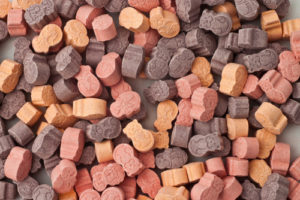
Multivitamins
Some parents make taking a multivitamin part of their morning routine, while others never do. There is no real consensus on it – experts disagree about vitamins for children who don’t display signs of deficiency, while others claim that a multivitamin can be like an “insurance policy” that can fill in the gaps of a not-so-great diet or for picky eaters.
You should really consult your pediatrician about this. If you do decide to give your child a multivitamin (and your pediatrician agrees), choose one that’s formulated specifically for children, and make sure it provides about 100% (not much more!) of the RDA for all the vitamins and minerals listed.
Here are a few reputable children’s multivitamins:
- Flintstones Complete
- Puritan’s Pride Multi Chewables
- One-a-Day Kids Complete (Chewable, not gummies)
- Freeda Vitales (100% vegetarian, and yeast, gluten, and lactose free)
Following the dosage listed on the label, keep the jar tightly capped on a high shelf, and make sure your kids know that vitamins are NOT candy. Children can overdose on vitamins, so be vigilant! Gummy vitamins are not recommended since they stick to the teeth and can cause decay.
Fiber
Fiber is also important for kids: Fiber-rich foods help regulate weight and mood, and they help prevent constipation. A great rule for determining how much daily fiber your child needs is “age + 5 grams.”
For example: A ten year old child requires about 15 grams of fiber a day.
First and foremost, try to increase fiber through kidfriendly whole grains, fruits and vegetable. High-fiber breakfast cereals and grains are an easy way to provide a fiber fix. If your child is struggling with chronic constipation and requires an extra dose, talk to your pediatrician about adding a fiber supplement.
You can try some of the following:
- Benefiber Powder
- Juice + Fiber (10 grams of fi ber per 8 ounce box)
- Now’s Inulin Powder (found at Trader Joe’s)
Calcium and D
It’s true that children don’t drink as much milk as they used to but that’s the reason a lot of kid-friendly foods are now fortifi ed with calcium. So before going the supplement route, parents should do a weekly “calcium tally” with their children to determine whether it’s needed.
Calcium Requirements:
Ages 1-3 = 500 mg a day
Ages 4-8 = 800 mg a day
Ages 9-18 =1,300 mg a day
If your child comes up short on the weekly tally and you can’t find a way to get more calcium-rich foods onto the menu, talk to your pediatrician. If you decide to add a supplement, look for one that contains vitamin D, which we need to help absorb calcium. Viactiv calcium chews come in a variety of fl avors and tend to be well accepted by children of all ages. On the other hand, if your child has braces or is anything like my 11 year old son, Billy, who will not go near a chewy, you can resort to a pill. And if your child cannot swallow a pill, you can mash up one “Caltrate 600 plus D” and mix it in a yogurt or pudding.
Last but not least…
Make sure your kids brush their teeth after taking chewable vitamins. Do not leave vitamins or any other supplements within reach of children. And be sure to talk to your child’s doctor before you begin any vitamin or supplement routine.
Teaching Your Child The Importance Of Good Oral Hygiene
Teaching your child the importance of good oral hygiene is one of the best things you can do for your child. This will help prevent cavities and tooth loss. Baby teeth are just as important as adult teeth for chewing, speech and self-esteem. Explain each step of the brushing process to your child as you do it. Brush the inside surfaces of all the teeth, using a circular motion and making sure to angle the toothbrush toward the gum line. Next, brush the outside surfaces of the teeth with the same short, circular motions. Finally, brush the chewing surfaces, and then the tongue.
Brushing together as a family is another way to help your child develop good brushing habits.
Brush for 2-3 min. each time, setting a timer if necessary. This gives your child a good idea of what the right amount of time to spend brushing feels like. Brushing along to a favorite song can act as a timer and also makes brushing lots of fun.
Getting children involved in the decision-making process can encourage them to brush and make dental hygiene more enjoyable for them. Why not let them pick out their own child toothbrush and toothpaste – there are many on the market.
Alternative in-between cleaners such as dental picks aren’t safe or effective for kids. Flossing your child’s teeth is the best bet and should be done when your child’s teeth start to come closer together. Food will be more easily trapped between the teeth and brushing may not be enough to thoroughly clean them. Just like adults, kids need to floss once a day during their night time routine. Flossing between every single tooth and the back molars is important for a healthy mouth. This is when the teeth have the most food and plaque build-up and will benefit the most from flossing. Children also shouldn’t use mouthwash until they’re at least 6 years old.
Teaching your child the importance of dental care early on will lay the foundation for a lifetime of healthy teeth and a great smile!
